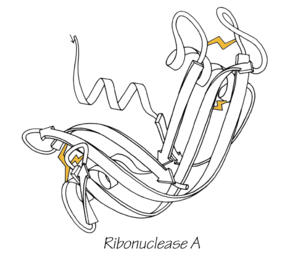Christian B. Anfinsen facts for kids
Quick facts for kids
Christian B. Anfinsen
|
|
|---|---|

Anfinsen in 1969
|
|
| Born |
Christian Boehmer Anfinsen Jr.
March 26, 1916 |
| Died | May 14, 1995 (aged 79) |
| Alma mater |
|
| Known for | Ribonuclease, Anfinsen's dogma |
| Spouse(s) |
|
| Children | 3 with Kenenger, 4 stepchildren with Ely |
| Awards | Nobel Prize in Chemistry (1972) |
| Scientific career | |
| Fields | Biochemistry |
| Thesis | Quantitative histochemical studies of the retina (1943) |
| Doctoral advisor | Albert Baird Hastings |
Christian Boehmer Anfinsen Jr. (born March 26, 1916 – died May 14, 1995) was an American biochemist. He won the 1972 Nobel Prize in Chemistry. He shared this award with Stanford Moore and William Howard Stein. They were recognized for their work on a special protein called ribonuclease. Their research showed how a protein's structure is linked to its function. This idea is now known as Anfinsen's dogma.
Contents
About Christian Anfinsen's Early Life
Christian Anfinsen was born in Monessen, Pennsylvania. His family had moved there from Norway. His father, Christian Boehmer Anfinsen Sr., was a mechanical engineer. In the 1920s, his family moved to Philadelphia.
Education and Early Studies
In 1933, Christian started college at Swarthmore College. He played football there and earned a bachelor's degree in chemistry in 1937. He then got a master's degree in organic chemistry in 1939. This was from the University of Pennsylvania.
He received a special scholarship to study in Denmark. He went to the Carlsberg Laboratory in Copenhagen. There, he learned new ways to study the chemical structure of complex proteins. These proteins include enzymes, which help speed up chemical reactions in the body.
In 1941, Anfinsen began his PhD studies. He went to Harvard Medical School. He earned his PhD in biochemistry in 1943. During World War II, he worked for a government research office.
Family Life
Christian Anfinsen had three children with his first wife, Florence Kenenger. They were married from 1941 to 1978. In 1979, he married Libby Shulman Ely. He gained four stepchildren through this marriage. He also converted to Orthodox Judaism.
Christian Anfinsen's Amazing Career
In 1950, Christian Anfinsen joined the National Institutes of Health (NIH). This is a big research center in Bethesda, Maryland. He became the head of the cell physiology lab.
Traveling for Science
In 1954, Anfinsen received a special fellowship. This allowed him to return to the Carlsberg Laboratory in Denmark for a year. Later, from 1958 to 1959, he studied in Israel. He worked at the Weizmann Institute of Science. In 1958, he was chosen as a Fellow of the American Academy of Arts and Sciences.
Leading Research Labs
In 1962, Anfinsen went back to Harvard Medical School. He was a visiting professor there. He was also asked to lead the chemistry department. After that, he became the chief of the chemical biology lab at another NIH institute. He stayed there until 1981.
In 1981, Anfinsen helped start the World Cultural Council. This group promotes science and culture worldwide. From 1982 until he passed away in 1995, he was a professor at Johns Hopkins University.
Anfinsen wrote over 200 scientific articles. Most of his work focused on how the structure of proteins relates to what they do. He also wrote a book called "The Molecular Basis of Evolution" (1959). In this book, he talked about how protein chemistry and genetics are connected. He also explored how these fields could help us understand evolution.
Discovering Protein Folding Secrets
Anfinsen was a pioneer in understanding how proteins fold. In 1961, he made a very important discovery. He showed that a protein called ribonuclease could be unfolded and then refold itself. Even after unfolding, it could still work correctly. This meant that all the information a protein needs to get its final shape is found in its basic chain of amino acids. This idea is called Anfinsen's dogma.
He was a member of several important scientific groups. These included the United States National Academy of Sciences and the Royal Danish Academy of Sciences and Letters.
The Christian B. Anfinsen Award
The Christian B. Anfinsen Award was created in 1996. It is given out every year to important scientists. This award celebrates excellent achievements in protein science. It also honors people who have shown great leadership, helped with education, or provided service in the field. The Protein Society sponsors this award. It recognizes major technical breakthroughs in protein science.
See also
 In Spanish: Christian B. Anfinsen para niños
In Spanish: Christian B. Anfinsen para niños
- Anfinsen's dogma
- List of Jewish Nobel laureates



